Abstract
The charts of 480 patients with secondary bacterial peritonitis were reviewed. The antibiotics used were compared with the culture and sensitivity data obtained at surgery, and the outcomes of patients were evaluated. Patients treated with a single broad-spectrum antibiotic had a better outcome than patients treated with multiple drug treatment. Inadequate empiric antibiotic treatment was associated with poorer outcome than any other type of treatment. The outcome of this inadequate treatment group could not be improved by any antibiotic response to culture and sensitivity information after operation. Those patients treated with antibiotic coverage for anticipated organisms and having no cultures taken did as well as patients having cultures taken. Surgeons typically ignore culture data after operation, and only 8.8% of patients in this study had an appropriate change in antibiotic treatment after operation. A benefit from obtaining operative cultures could not be identified.
Full text
PDF
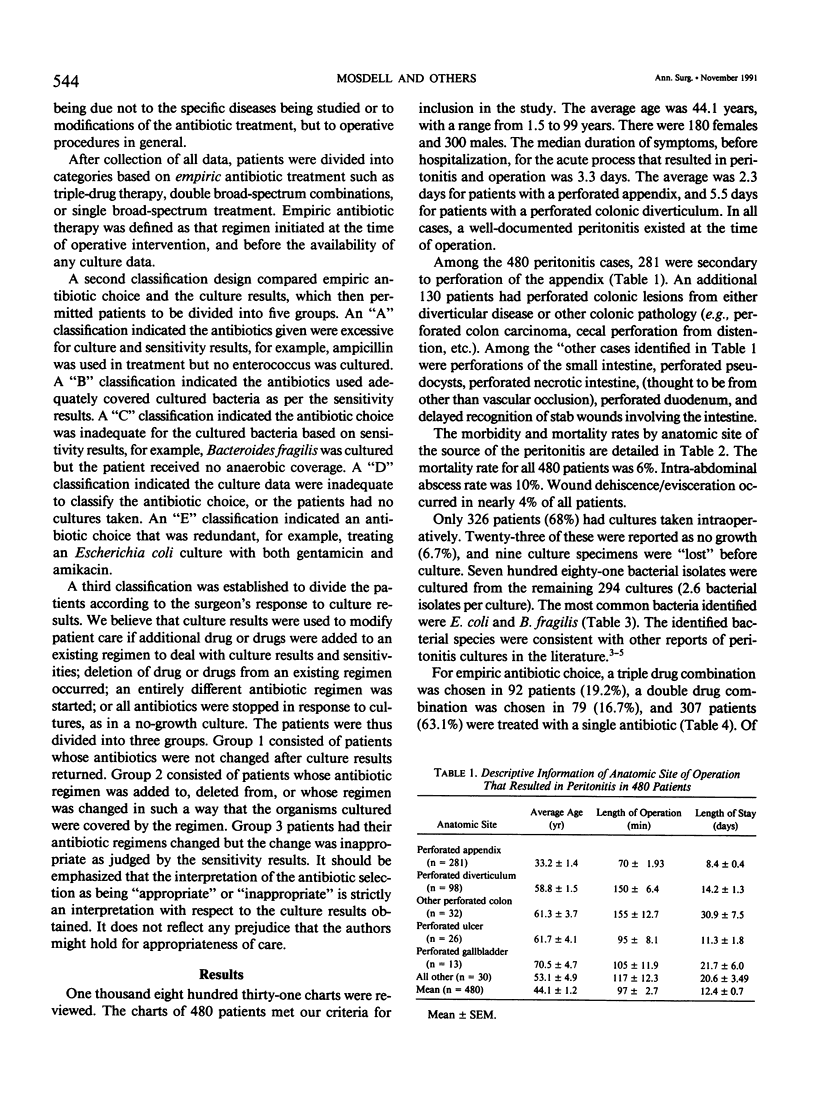
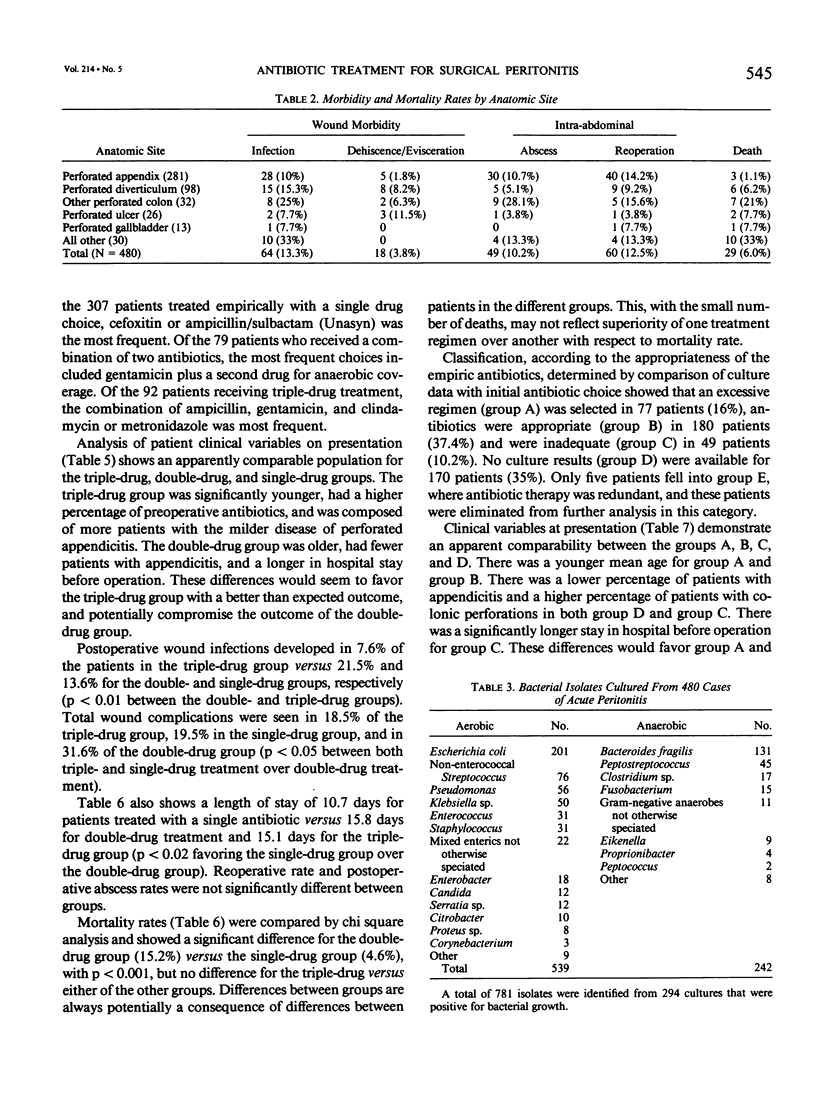
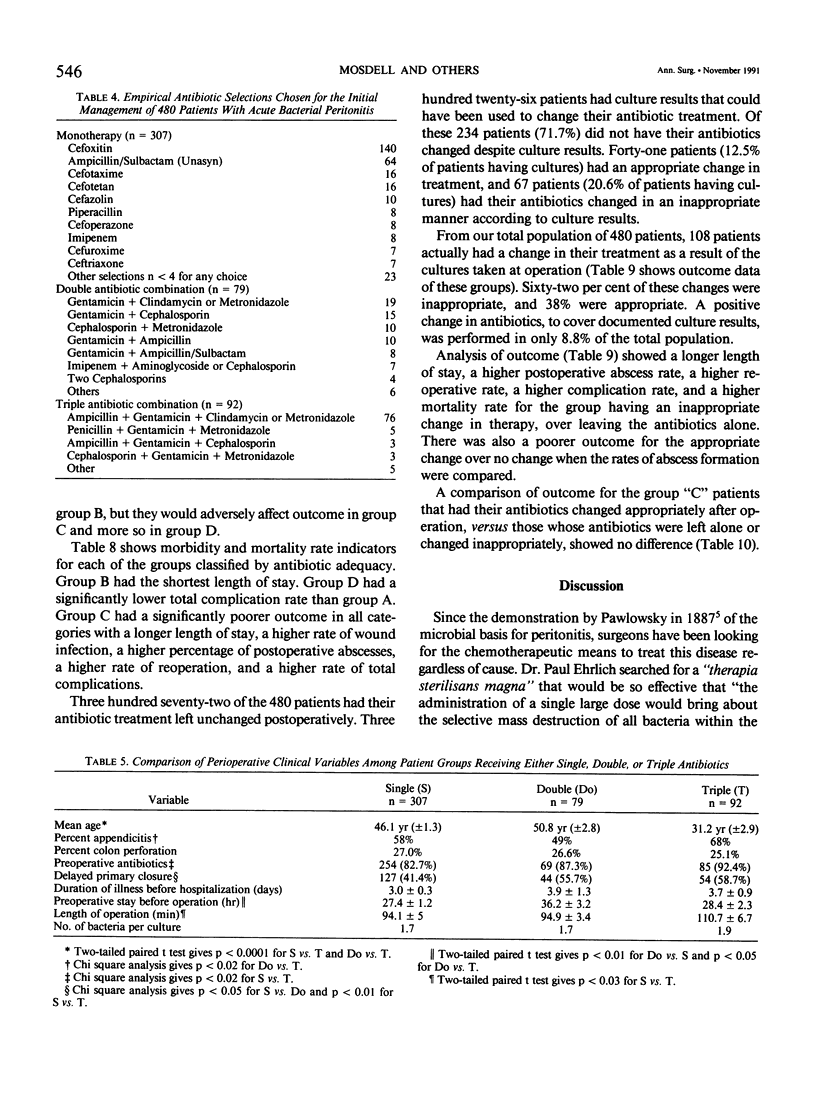
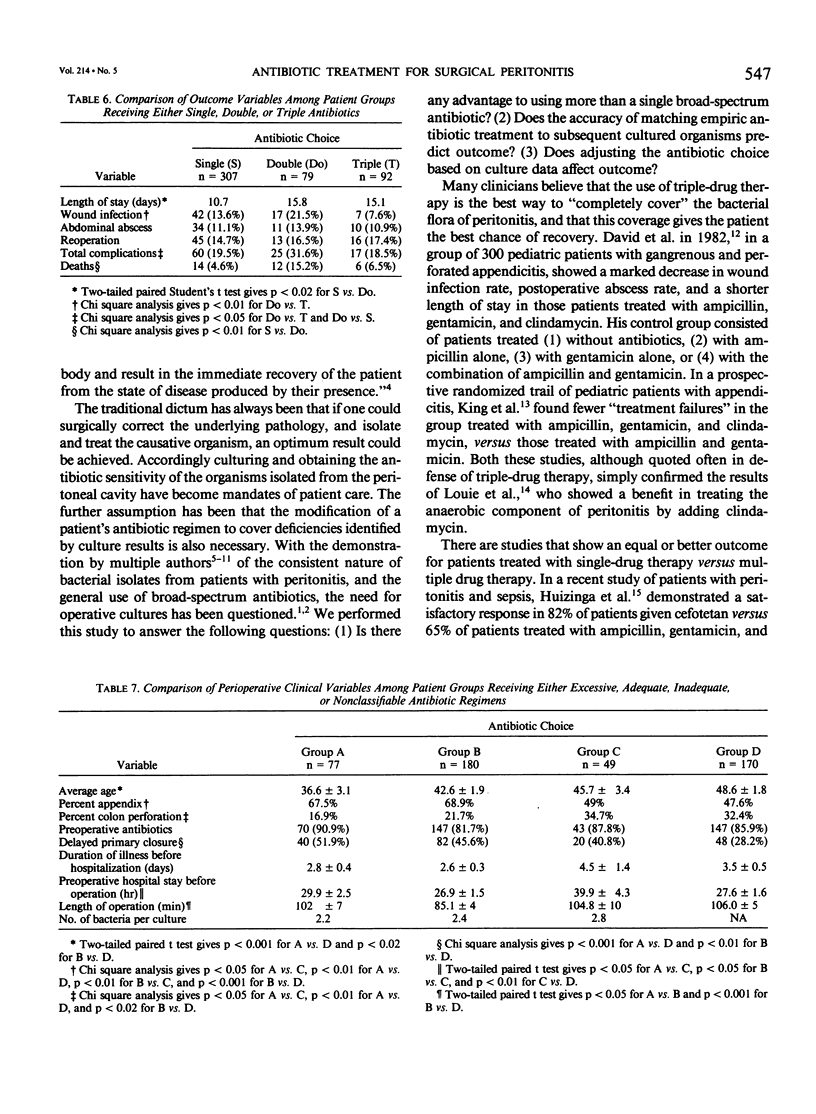
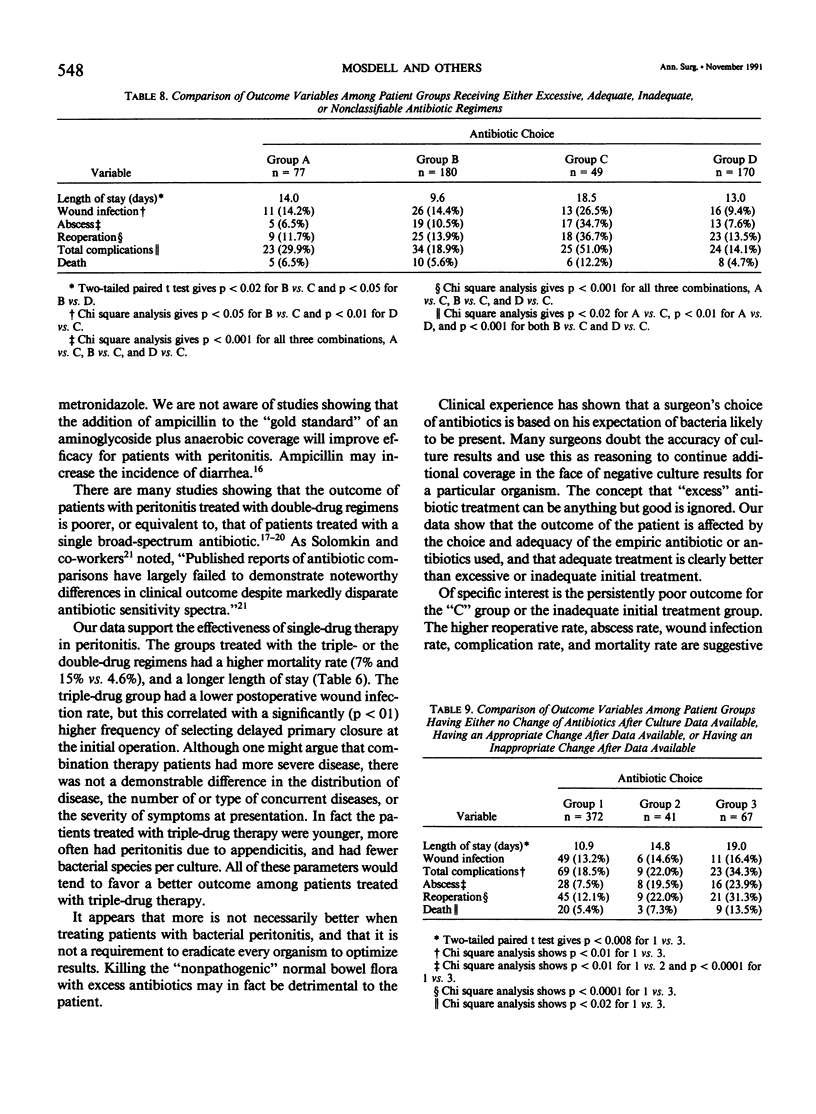
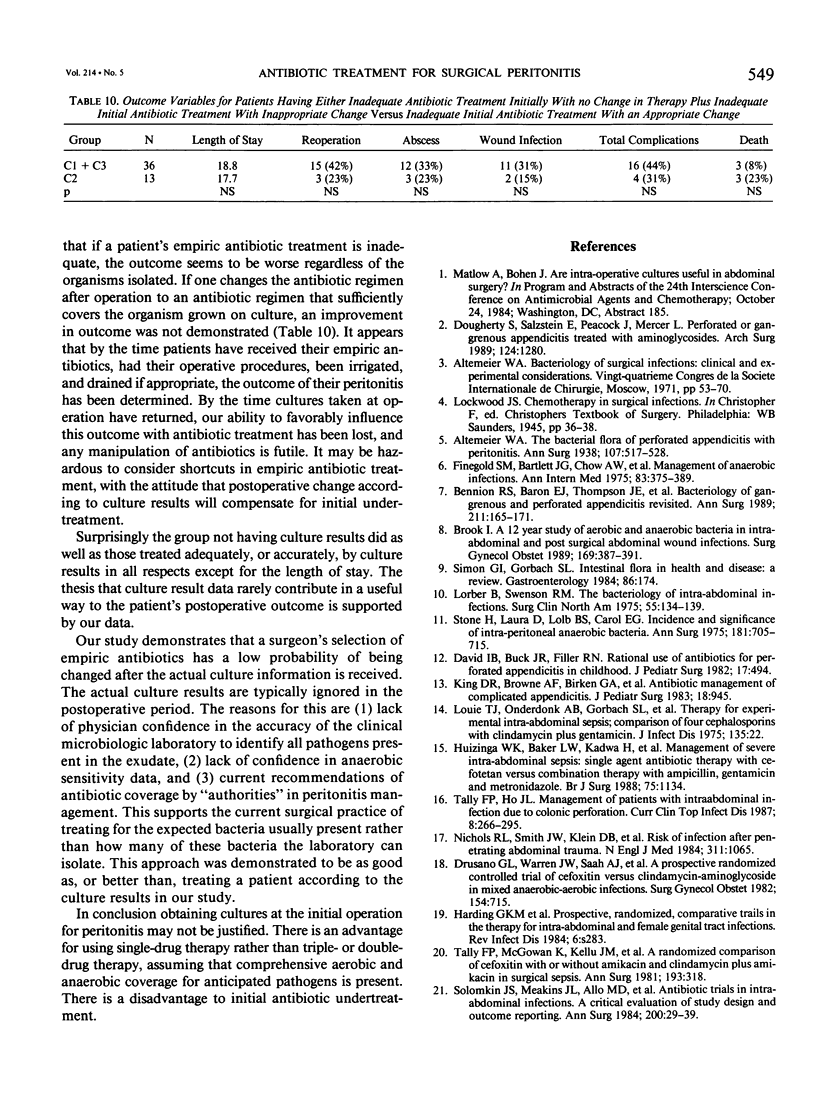
Selected References
These references are in PubMed. This may not be the complete list of references from this article.
- Altemeier W. A. THE BACTERIAL FLORA OF ACUTE PERFORATED APPENDICITIS WITH PERITONITIS: A BACTERIOLOGIC STUDY BASED UPON ONE HUNDRED CASES. Ann Surg. 1938 Apr;107(4):517–528. doi: 10.1097/00000658-193804000-00006. [DOI] [PMC free article] [PubMed] [Google Scholar]
- Bennion R. S., Baron E. J., Thompson J. E., Jr, Downes J., Summanen P., Talan D. A., Finegold S. M. The bacteriology of gangrenous and perforated appendicitis--revisited. Ann Surg. 1990 Feb;211(2):165–171. doi: 10.1097/00000658-199002000-00008. [DOI] [PMC free article] [PubMed] [Google Scholar]
- Brook I. A 12 year study of aerobic and anaerobic bacteria in intra-abdominal and postsurgical abdominal wound infections. Surg Gynecol Obstet. 1989 Nov;169(5):387–392. [PubMed] [Google Scholar]
- David I. B., Buck J. R., Filler R. M. Rational use of antibiotics for perforated appendicitis in childhood. J Pediatr Surg. 1982 Oct;17(5):494–500. doi: 10.1016/s0022-3468(82)80096-1. [DOI] [PubMed] [Google Scholar]
- Dougherty S. H., Saltzstein E. C., Peacock J. B., Mercer L. C., Cano P. Perforated or gangrenous appendicitis treated with aminoglycosides. How do bacterial cultures influence management? Arch Surg. 1989 Nov;124(11):1280–1283. doi: 10.1001/archsurg.1989.01410110034006. [DOI] [PubMed] [Google Scholar]
- Drusano G. L., Warren J. W., Saah A. J., Caplan E. S., Tenney J. H., Hansen S., Granados J., Standiford H. C., Miller E. H., Jr A prospective randomized controlled trial of cefoxitin versus clindamycin-aminoglycoside in mixed anaerobic-aerobic infections. Surg Gynecol Obstet. 1982 May;154(5):715–720. [PubMed] [Google Scholar]
- Finegold S. M., Bartlett J. G., Chow A. W., Flora D. J., Gorbach S. L., Harder E. J., Tally F. P. Management of anaerobic infections. Ann Intern Med. 1975 Sep;83(3):375–389. doi: 10.7326/0003-4819-83-3-375. [DOI] [PubMed] [Google Scholar]
- Harding G. K., Nicolle L. E., Haase D. A., Aoki F. Y., Stiver H. G., Blanchard R. J., Kirkpatrick J. R. Prospective, randomized, comparative trials in the therapy for intraabdominal and female genital tract infections. Rev Infect Dis. 1984 Mar-Apr;6 (Suppl 1):S283–S292. doi: 10.1093/clinids/6.supplement_1.s283. [DOI] [PubMed] [Google Scholar]
- Huizinga W. K., Baker L. W., Kadwa H., van den Ende J., Francis A. J., Francis G. M. Management of severe intra-abdominal sepsis: single agent antibiotic therapy with cefotetan versus combination therapy with ampicillin, gentamicin and metronidazole. Br J Surg. 1988 Nov;75(11):1134–1138. doi: 10.1002/bjs.1800751126. [DOI] [PubMed] [Google Scholar]
- King D. R., Browne A. F., Birken G. A., Hilty M. D., Kerzner B., Boles E. T., Jr Antibiotic management of complicated appendicitis. J Pediatr Surg. 1983 Dec;18(6):945–950. doi: 10.1016/s0022-3468(83)80051-7. [DOI] [PubMed] [Google Scholar]
- Nichols R. L., Smith J. W., Klein D. B., Trunkey D. D., Cooper R. H., Adinolfi M. F., Mills J. Risk of infection after penetrating abdominal trauma. N Engl J Med. 1984 Oct 25;311(17):1065–1070. doi: 10.1056/NEJM198410253111701. [DOI] [PubMed] [Google Scholar]
- Simon G. L., Gorbach S. L. Intestinal flora in health and disease. Gastroenterology. 1984 Jan;86(1):174–193. [PubMed] [Google Scholar]
- Solomkin J. S., Meakins J. L., Jr, Allo M. D., Dellinger E. P., Simmons R. L. Antibiotic trials in intra-abdominal infections. A critical evaluation of study design and outcome reporting. Ann Surg. 1984 Jul;200(1):29–39. doi: 10.1097/00000658-198407000-00005. [DOI] [PMC free article] [PubMed] [Google Scholar]
- Stone H. H., Kolb L. D., Geheber C. E. Incidence and significance of intraperitoneal anaerobic bacteria. Ann Surg. 1975 May;181(5):705–715. doi: 10.1097/00000658-197505000-00027. [DOI] [PMC free article] [PubMed] [Google Scholar]
- Tally F. P., Ho J. L. Management of patients with intraabdominal infection due to colonic perforation. Curr Clin Top Infect Dis. 1987;8:266–295. [PubMed] [Google Scholar]
- Tally F. P., McGowan K., Kellum J. M., Gorbach S. L., O'Donnell T. F. A randomized comparison of cefoxitin with or without amikacin and clindamycin plus amikacin in surgical sepsis. Ann Surg. 1981 Mar;193(3):318–323. doi: 10.1097/00000658-198103000-00011. [DOI] [PMC free article] [PubMed] [Google Scholar]


